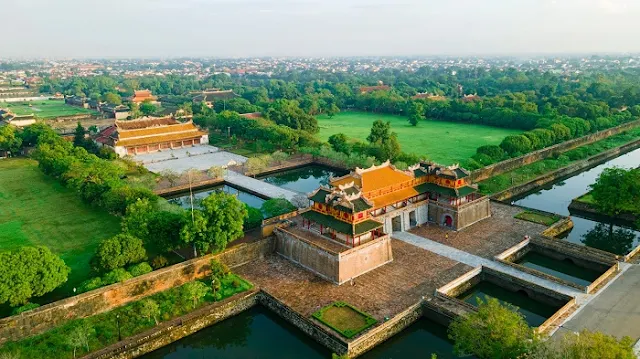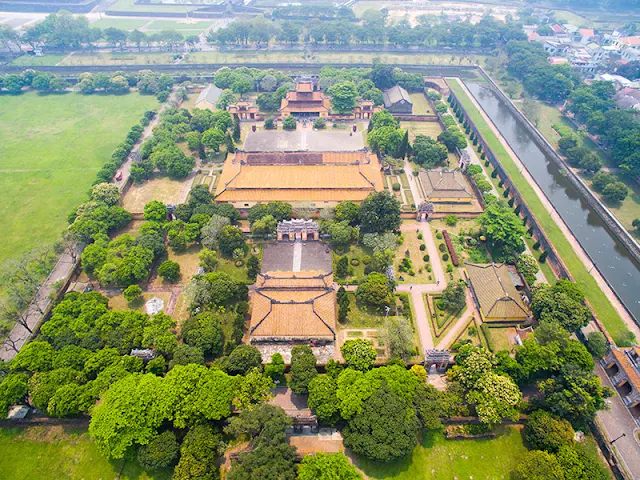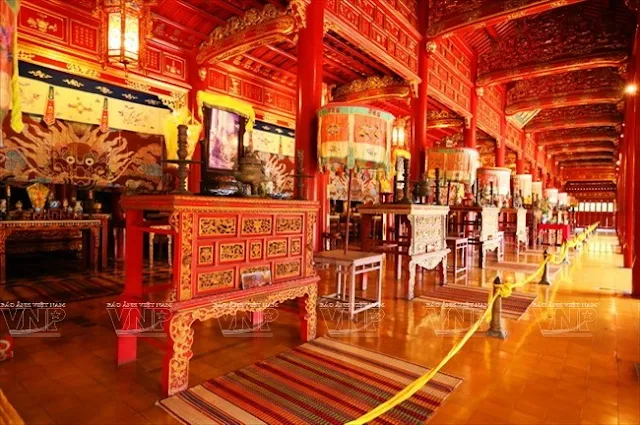The Hue Imperial Citadel, also known as the Imperial City of Hue, is a UNESCO World Heritage Site located in Hue, Vietnam. It was the former capital of the Nguyen Dynasty, which ruled Vietnam from 1802 to 1945. The Citadel is a complex of royal palaces, temples, and structures that served as the political and cultural center of the empire. The Hue Imperial Citadel is famous for its architectural beauty, blending traditional Vietnamese design with elements of Chinese and French influences. The complex is surrounded by a moat and massive walls that enclose various areas, including the Forbidden Purple City, the Royal Citadel, and the Inner and Outer Courts. Visitors to the Hue Imperial Citadel can explore the various buildings, many of which have been restored and renovated. Some highlights include the Thai Hoa Palace, the Halls of the Mandarins, the Royal Library, and the Nine Dynastic Urns. The complex offers insights into the rich history and culture of Vietnam and is a must-visit destination for history enthusiasts and architecture lovers.
TIME LINE
- September 2008 (2)
- December 2009 (1)
- January 2010 (1)
- March 2010 (2)
- January 2011 (13)
- February 2011 (6)
- March 2011 (3)
- April 2011 (6)
- May 2011 (2)
- June 2011 (20)
- July 2011 (72)
- August 2011 (35)
- September 2011 (10)
- October 2011 (73)
- November 2011 (11)
- December 2011 (6)
- January 2012 (6)
- February 2012 (1)
- March 2012 (5)
- April 2012 (1)
- May 2012 (2)
- June 2012 (3)
- July 2012 (5)
- December 2012 (1)
- July 2013 (1)
- August 2013 (1)
- September 2013 (1)
- November 2013 (1)
- February 2014 (1)
- April 2014 (1)
- May 2014 (3)
- July 2014 (1)
- August 2014 (1)
- October 2014 (1)
- May 2015 (1)
- August 2015 (1)
- November 2015 (2)
- January 2016 (1)
- February 2016 (2)
- March 2016 (3)
- May 2016 (2)
- July 2016 (1)
- September 2017 (1)
- March 2018 (1)
- May 2018 (1)
- August 2018 (1)
- January 2019 (1)
- May 2019 (1)
- September 2019 (1)
- February 2020 (1)
- April 2020 (2)
- July 2020 (1)
- September 2020 (2)
- October 2020 (1)
- November 2020 (1)
- February 2021 (3)
- April 2021 (3)
- May 2021 (11)
- June 2021 (4)
- July 2021 (3)
- August 2021 (1)
- September 2021 (1)
- October 2021 (4)
- January 2022 (1)
- May 2022 (9)
- August 2022 (1)
- September 2022 (1)
- October 2022 (2)
- December 2022 (1)
- February 2023 (2)
- March 2023 (6)
- April 2023 (10)
- May 2023 (18)
- June 2023 (40)
- July 2023 (86)
- August 2023 (21)
- September 2023 (14)
- October 2023 (39)
- November 2023 (25)
- December 2023 (18)
- January 2024 (15)
- February 2024 (12)
- March 2024 (4)
- April 2024 (9)
- May 2024 (17)
- June 2024 (18)
- July 2024 (21)
- August 2024 (28)
- September 2024 (17)
- October 2024 (17)
- November 2024 (22)
- December 2024 (17)
- January 2025 (9)
- February 2025 (9)
- March 2025 (13)
- April 2025 (10)
- May 2025 (11)
- June 2025 (6)
- July 2025 (22)
- August 2025 (3)
- September 2025 (8)
- October 2025 (8)
- November 2025 (9)
- December 2025 (4)
Sunday, August 27, 2023
The Hue Imperial Citadel
The architectural planning and design of the Hue Imperial Citadel in Vietnam were overseen by a team of Vietnamese architects and engineers during the Nguyen Dynasty. The exact names of the architects involved in the original construction are not widely known or documented. However, the overall layout and design of the Citadel were inspired by traditional Vietnamese architectural principles and influenced by Chinese imperial architecture. The construction of the citadel began in 1804 under the reign of Emperor Gia Long, and subsequent emperors made additions and modifications to the complex over the years. It's worth noting that the restoration and preservation efforts of the Hue Imperial Citadel in recent years have involved collaborations between local and international organizations, including historians, architects, and conservation experts. They have worked together to restore and protect the site's architectural integrity and cultural significance.
Labels:
Cultural,
Documentation,
Heritage,
Huế,
Việt Nam
Location:
Thành phố Huế, Thừa Thiên Huế, Việt Nam
 Interior Designer: Life style - Comunity - Works
Mobile: (+84) 975675278
Email : tuannha.id@gmail.com
Interior Designer: Life style - Comunity - Works
Mobile: (+84) 975675278
Email : tuannha.id@gmail.com
Subscribe to:
Post Comments (Atom)




























No comments:
Post a Comment